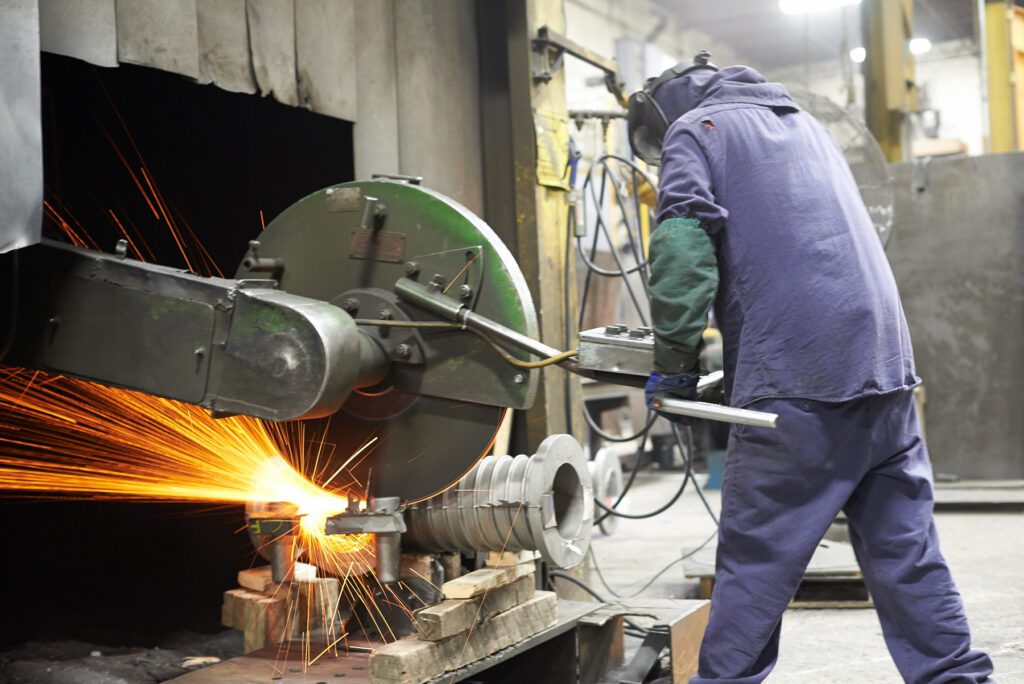
The shakeout, cutoff and cleaning process in metal casting is a major intermediate step in preparing a casting for final use. While this phase can be the last step in a foundry’s process, the final stage in metal casting depends on the end-use requirements, customer specifications, and industry standards. Many OEMs and ASTM specifications require additional steps after cleaning, like heat treatment, machining, or Non-destructive testing, especially in high-spec or high-performance industries such as oil and gas, military/defense, food and beverage, and pharmaceutical equipment manufacturing.
Shakeout
After a metal casting has been poured, cooled and solidified, it is removed from the mold through the shake or shakeout process. During “shakeout,” the mold is broken apart – or shaken – using mechanical vibration to free the casting. The sand from the mold is then typically collected for recycling, where the sand is moved through a reclamation unit that removes the binders and other impurities from the sand. This process allows foundries to reuse most of the sand for future molds; in the past thousands of tons of sand were dumped each year into landfills.
Cutoff
After it is separated from the loose sand, the casting moves to the cutoff process, where excess metal components, like gates, risers, runners, etc., are removed from the casting. When castings are poured, molten metal fills not only the cavity that forms the actual part; it fills the attached channels used to deliver and feed the metal during solidification. These gates and risers are not part of the final product, so they must be cut off using saws, torches, hydraulic shears, or air arc cutters. Cutoff scrap can be cleaned and recycled for reuse.
If not removed properly, these non-functional parts of the casting could cause stress on the casting and result in cracking. At this stage, foundrymen ensure the accuracy of the casting’s dimensions, weight and shape prior to moving the part for further finishing processes like grinding, cleaning and machining.
Cleaning
After the casting has been shaken and cut off, it goes through a cleaning process. This includes removing surface discontinuities, riser pads, and gate contacts to improve the casting’s appearance and preparing the casting for inspection and/or further machining.
After the initial cleaning process, the casting is inspected for surface defects, incomplete cleaning, or casting flaws like cracks, porosity or inclusions. If quality control personnel identify a flaw at this stage, they determine whether to rework, repair, or reject the casting.
If a casting passes visual inspection, many OEMs require additional non-destructive testing (NDT). NDT is required for castings that must meet high safety, reliability, and/or performance standards, especially in critical applications where defects could lead to service failure. Badger Alloys offers all levels of ASTM, ASME, and MIL-STD industry standard testing on site.
Critical, but (typically) not the last step
The Shakeout/Cutoff/Cleaning process is critical, but it’s usually not the final step in a casting’s journey through the foundry. Depending on the casting and its application, post-cleaning processes may include machining, heat treatment, NDT, surface coating, assembly, and final quality inspection.
Our customers appreciate that Badger Alloys is a full-service casting manufacturer that can see their projects through from CAD to finish machined product. For more information about our engineering, patternmaking, sand casting, machining, and quality testing, visit us at badgeralloys.com or contact us at 414/258-8200 today.